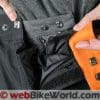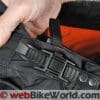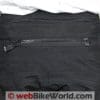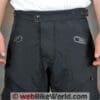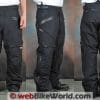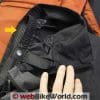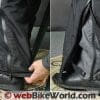This is the third review of Firstgear TPG products; first was the original Rainier TPG jacket (review), reviewed in 2008.
One year ago, in November of 2009, I reviewed the updated Firstgear Teton TPG jacket along with the matching Firstgear TPG Escape pants.
Now in November 2010 I’m reviewing “Version 3” of the Rainier TPG jacket, a mild update, along with a more radical update of the Firstgear Escape TPG pants.
The reason we’re spending so much time and effort on the Firstgear TPG products with these multiple reviews is due to their enduring popularity with motorcyclists.
Also, anyone looking for a high-quality outfit without taking the next jump to more expensive high-tech gear from brands like REV’IT!, Klim or Rukka.
The original Firstgear Escape TPG pants were very good and one of my favorites.
but with so much gear around here, I ended up selling them last Spring in a webBikeWorld garage sale. So I was anxious to try “Version 2” of the Escape pants to see what’s new.
Actually, so much has been changed that these Version 2 Escape pants can’t really be compared to Version 1.
It’s very puzzling to me why Firstgear would so radically change a pant that was one of the best around.
One of the big differences is that the Version 2 pants are now considered overpants.
This makes the fit seem much bigger than before. But if they’re overpants, then why did Firstgear add a new removable liner that they say can be used as a pair of street pants?
Not sure about that, and the liner doesn’t look like any pair of street pants that I’d ever want to wear. I’d rather walk into the store wearing the black Escape pants.
The other big change was at the leg cuffs.
I no longer have the original Escape pants here to compare, but the new version has a sewn-in vinyl apron “storm flap” at the leg cuff, with a piece of elastic at the bottom.
I’m not fond of motorcycle pants with this feature because it makes it difficult to put the pants on over the boots.
The storm flap makes it harder to slip into the pants without first undoing the outer leg zipper, then the inner liner zipper and then unbuttoning the storm flap, then buttoning and zipping everything up again when the pants and boots are on.
Either way, it makes the dressing routine more complicated.
The storm flap curtain is permanently sewn into the bottom at the inside of the pant legs.
It snaps open and it must also be fitted around the outside of the inner liner pant, which also has a zipper that runs about 20″ up the outside of the leg.
I’m not sure if the storm curtain is more efficient at keeping out rain and wind anyway when compared to a well-designed outer leg flap system that allows you to simply cinch up the leg to the desired tightness.
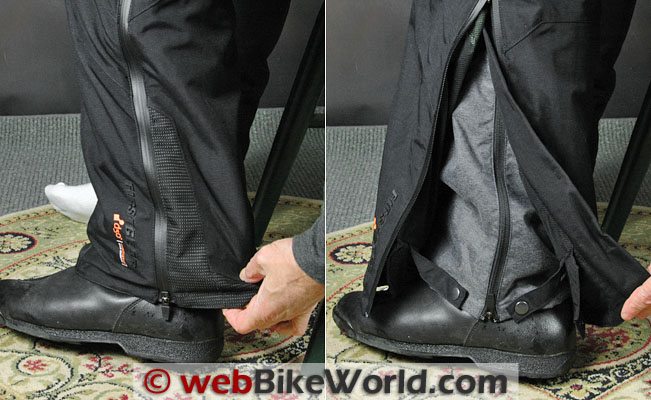
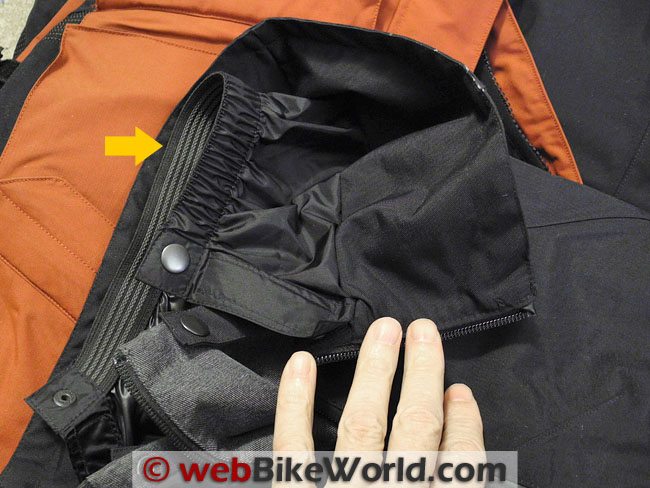
Where’s the Leg Cuff Cinch?
There are more changes. The new version of the Escape pants does not have an external flap or method to allow the rider to tighten the bottom of the pant leg at the cuff.
Version 1 of the Escape pants didn’t have this feature either; the flap shown in the photos in that review covers the zipper only.
But the legs on the newer version are a wide 10″ across at the very bottom, which is about 1-1/2 inches wider than the originals.
It is possible that the designers added more room at the bottom of the pants to accommodate a pair of heavy adventure-touring boots, although the styling of the Escape pants does not says “touring” to me, not adventure-touring.
The absence of any way to tighten up the bottom of the legs is an oversight, in my opinion.
The wider cross section now makes the legs feel too loose and they can billow out and flap around when riding because they can’t be cinched tight.
Every motorcycle pant needs a method to cinch up the bottom at the cuff, and these don’t have it.
The originals did, and the Rev’it Defender GTX pants Burn and I have been evaluating simultaneously have a very wide ranging cinch system and this is sorely missed on the Firstgear pants.
Besides not having a way to snug up the cuffs, the entire leg width feels wider than I remember, although a quick call to the owner of the original Escape pants confirmed that the width is the same — around 10.5″ at the knee.
The loose fit at the bottom of the leg does translate into a looser feeling for most of the leg from the cuff upwards, and overall the pants overall seem to run at least one size big.
The original Escape pants also fit slightly larger than expected for a size large, but the new version seems even larger.
The model in the photos is about 6 feet tall and usually takes size XL with about a 38″ waist and 31″ inseam and you can see these size large pants look too big on him.
In comparison, the Rev’it Defender GTX pants are also a size large and they have a much trimmer fit.
The model could barely fit into them, so they may be slightly undersize (they fit me perfectly) but in reality, they fit closer to a size large than these Escape pants. Besides, a trimmer fit is better for safety reasons.
The legs on the new Escape pants have an external waterproof zipper that extends up about 20″. I don’t believe the original Escape pants were designed as overpants; this new version is, a big difference.
The Firstgear website confirms that these are overpants with the statement that the “overpant is sized to fit over your clothes; simply buy the size you normally wear”.
If they’re overpants though, then why do they have a liner that is supposed to be used as a pair of wearable pants?
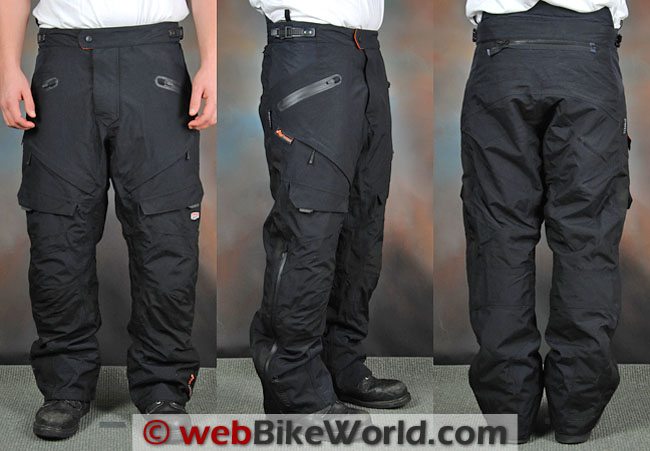
Wearable Lined Liner?
The gray colored liner “street pants” attach to the shell with a full-length zipper at the inside of the waist.
The pair of pants that acts as the liner also has its own insulation in the form of a separate thermal lining permanently attached on the inside.
The thermal liner material seems at odds with the soft and comfy microfiber used in most of the Firstgear TPG clothing.
It would have been better and more comfortable to have a soft fleece lining rather than the shiny and cold-feeling taffeta on the inside of the legs.
Unless I’m wearing a pair of tights, the insulation used in the pants feels cold against the bare skin of my legs.
Also, the loose overall fit of the pants creates an air space between my legs and the pants, so the lining remains cold and makes my legs feel even colder.
Zippers, Hooks and Vents
One good thing about both the wearable liner/pants and the Escape pants shell is they both have a metal snap and a metal hook.
A metal hook is a requirement on motorcycle pants and even the much more expensive Rev’it Defender pants don’t have one.
Also, the pants have a ratcheting adjuster mechanism on the side with about 1.5″ of adjustment. It’s easy to use, but so was Velcro and with fewer moving parts.
The design looks sturdy enough so I don’t think it will pull or tear the fabric in the waist, but it does add a slight amount of bulk.
The Escape pants have vents across the legs at mid-thigh, covered with a waterproof YKK zippers.
The pants did not leak any water during our rain escapades; they use the same “Hypertex Plus” waterproof and breathable 600 denier nylon outer shell as on the Rainier TPG jacket. The pants dried just as fast as the jacket, which is a plus.
The pants have the same “Teramid reinforced Kevlar” material apparently placed under the knees for abrasion protection.
The two hand pockets in front also use the YKK waterproof zippers and there are now two front cargo pockets with a flap and waterproof zipper underneath.
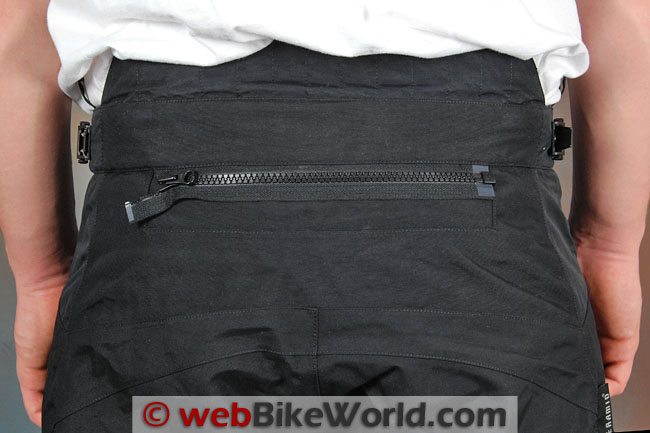
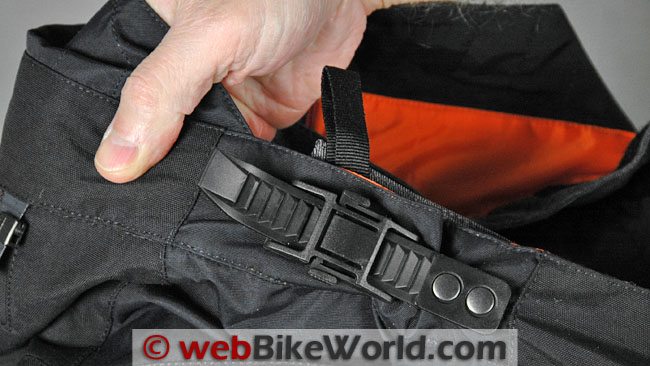
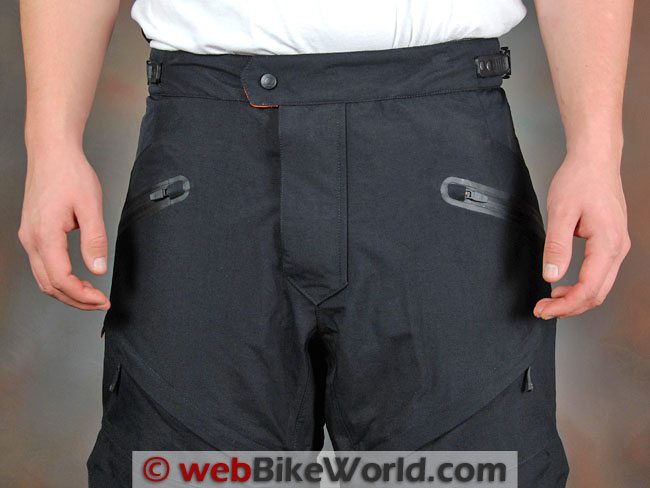
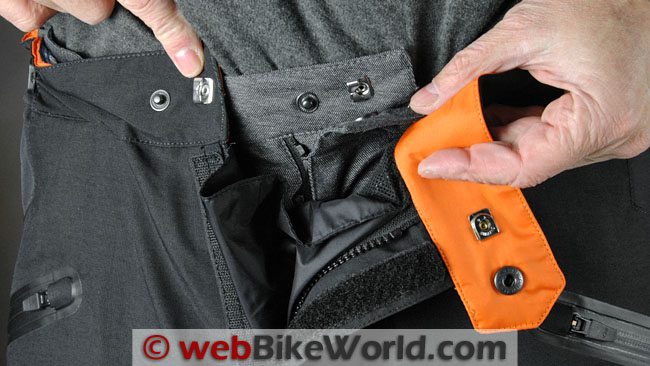
Conclusion
I’m disappointed with the “Version 2” revision to the Firstgear Escape pants.
The originals were nearly perfect and perhaps other than needing perhaps a slight revision of the front cargo pocket design, there was nothing to change.
The Escape pants are now overpants, a design which usually involves a lot of compromises that are unfortunately not handled very well here.
So unlike the continuous improvement of Firstgear jackets, this redesign is a step backward in my opinion.
My frank opinion is that the redesign borders on being gimmicky.
It’s something I’d expect from one of the lower-priced mass-market brands and not Firstgear, which has been trying to carve out a niche as a more reasonably priced purveyor of higher-quality gear.
My suggestion is this: if you’re looking for a nice pair of Firstgear pants to match your Rainier or Teton jacket (or any other jacket for that matter), find a retailer who has the original Escape pants still in stock and buy them while you can.
| wBW Product Review: 2011 Firstgear Escape TPG Pants | |
|---|---|
| Manufacturer: Firstgear | List Price: $329.95 |
| Colors: Black | Made In: China |
| Sizes: 30-48; Tall 34-40; Short 34-40. Women’s 6-18. | Review Date: November 2010 |
Note: Item provided by a retailer, distributor or manufacturer with these Terms and Conditions.
Owner Comments and Feedback
See details on submitting comments.
From “B.Z.” (11/10): “Looking over the reviews of both (and owning V1), I wanted to share some observations I noticed also.
The thigh side vents on V1 are more vertical ( in the standing position) and more so along the side of the pant.
I am not sure how the newer version of the vents across the front of the leg on the V2 pants, which are in a more of a horizontal fashion, are actually catching the wind for to ventilate.
But it seems to me the only improvement there is because of possible situations for crashability scenarios.
It strikes me though, with the air dynamics of wind flow around a motorcycle, that the vents in V1 (which work very well) would be in the draft to catch more air than the positioning in V2.
From an initial eyeball of the 2 versions, it also seems there is less (or at least less obvious anyway) reflective material used in the V2.
Also I noticed the deletion of the back pockets from V1 to V2.
The added cargo pocket on the left leg on V2 is nice, but it seems the placement of the cargo pockets is now lower down the leg with the adding in of the across the thigh zipper vent.
Which makes me wonder how anything in those pockets will affect your knee or how close is puts those kinds of items in proximity of.
From the long term point of view, I can see the advantage of having hardware over hook-and-loop ( a.k.a.- Velcro) for the waist adjusters.
The hook-and-loop over time can pill and do the wearing out fuzzing that hook-and-loop does over time with regular repeated use.
Is it as quick and easy? Maybe not, and if the plastic hardware gets brittle, it can break, so it is a pick the better of 2 for your personal choice.
I am guessing that most gear manufacturers don’t necessarily “crash test” their products.
But if the legs are in fact wider (even if only at the bottom of the leg), it begs the question of whether or not the padding/armor will stay on place in a rolling or sliding on the ground situation, or if it will roll and cause more abrasion in the process.
The taper cut in the leg (of the V1) with how it is snug around the calf of my semi-adventure boot seems to help decrease my thought of this happening while the pants do naturally sit more so in place.
Maybe this is a misconception, for which I do not care to find out the real answer, but it is a thought.”


